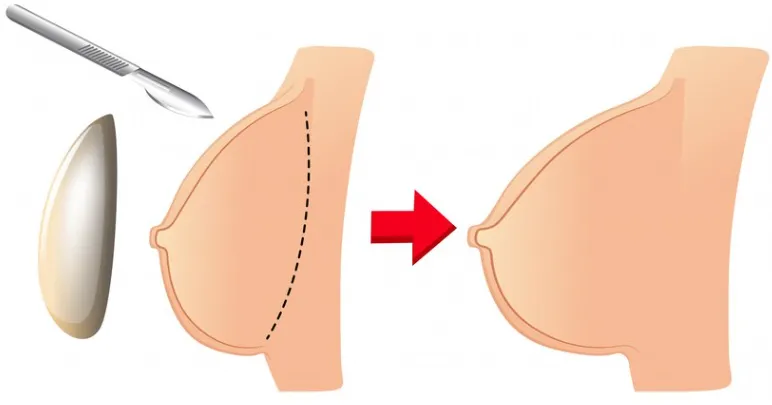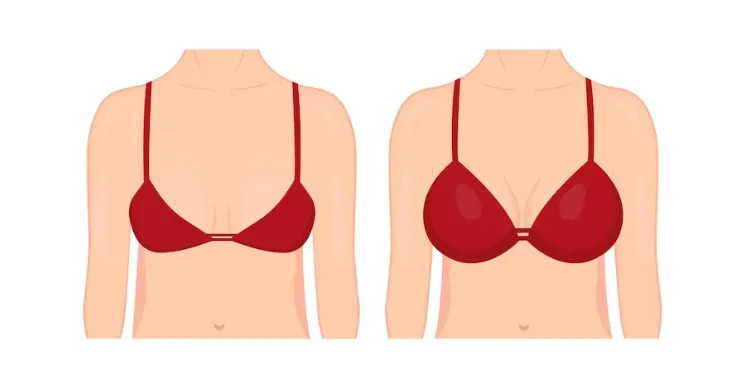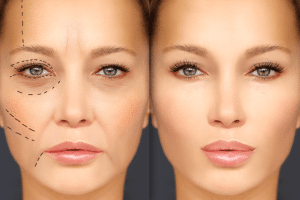Cosmetic surgery for breasts encompasses a variety of procedures designed to enhance and reshape the breast area to meet the aesthetic desires or functional needs of individuals. Breast augmentation utilizes advanced implant technology to increase size and improve the shape of the breasts, offering a more proportionate and desired silhouette. On the other hand, mastopexy, or breast lift, and breast reduction procedures address issues of sagging and oversized breasts, respectively, aiming to achieve a more comfortable and aesthetically pleasing appearance.
What is Breast Augmentation?
Breast augmentation, also known as augmentation mammoplasty, is a surgical procedure that involves increasing the size and improving the shape of the breasts. This procedure is typically sought by individuals who desire fuller breasts, have naturally small breasts, or have experienced changes in breast volume due to pregnancy, weight loss, or aging. Breast augmentation is often achieved through implants or fat transfer techniques.
Clinic contact number: +989371200167
Different Types of Cosmetic Surgery for Breasts
Cosmetic surgery for breasts encompasses a variety of procedures aimed at altering the size, shape, position, or appearance of the breasts. Here are some of the most common types:
Mammoplasty
Mammoplasty is a broad term encompassing various surgical procedures performed on the breasts. It includes breast augmentation, breast reduction, and breast lift.
Mammoplasty, also known as breast surgery or breast augmentation, is a surgical procedure designed to enhance the shape, size, and overall appearance of the breasts. It is a popular cosmetic surgery option chosen by individuals seeking to improve their self-confidence, restore breast symmetry, or reconstruct breasts following mastectomy. breast surgery has evolved, providing various options tailored to individual needs and goals.
Breast Augmentation
Breast augmentation in one of the Cosmetic Surgeries for Breasts involves increasing the size of the breasts by inserting implants or transferring fat from other body parts. Implants can be filled with saline solution or silicone gel, and they come in different shapes and sizes to meet individual preferences.
Breast Reduction
Breast reduction aims to decrease the size and weight of overly large breasts, relieving associated discomfort. This Cosmetic Surgery for Breasts procedure removes excess breast tissue and reshapes the breasts to achieve a more proportionate and balanced appearance.
Breast Lift
Also known as mastopexy, a breast lift is performed to lift and reshape sagging breasts. This Cosmetic Surgery for Breasts procedure involves removing excess skin, repositioning the nipples, and tightening the breast tissue, resulting in a more youthful and lifted breast contour.
Breast Reconstruction
Breast reconstruction is one of the Cosmetic Surgery for Breasts performed to recreate a breast removed due to cancer or other medical conditions. This procedure involves rebuilding the breast mound and, if desired, restoring the nipple and areola. Breast reconstruction can be done using various techniques, including implant-based reconstruction or autologous tissue flap reconstruction, which uses tissue from other body parts.
Prosthesis Paxi
Prosthesis Paxi, commonly referred to as breast prosthesis or breast forms, is a non-surgical option for individuals who desire breast enhancement. These external breast forms are made of silicone or other materials and can be worn inside a bra or adhered to the chest wall. Breast forms come in different shapes, sizes, and weights, providing a customizable solution for those seeking breast augmentation without surgery.
Breast implants are medical devices used in cosmetic and reconstructive breast surgery to enhance breast size, shape, and projection. They are typically made of a silicone shell filled with either saline (sterile saltwater) or silicone gel. Here are some key aspects of breast implants:
Clinic contact number: +989371200167
Types of Breast Implants
-
- Saline Implants: These implants are filled with sterile saline solution after insertion, allowing for adjustments in size during surgery. In case of rupture, saline is harmlessly absorbed by the body.
- Silicone Gel Implants: These implants are pre-filled with silicone gel, which closely mimics the feel of natural breast tissue. They are available in various shapes, including round and anatomical (teardrop-shaped), and consistencies, such as cohesive gel or highly cohesive gel.
Implant Shapes
-
- Round Implants: These implants are symmetrical and provide fullness in both the upper and lower poles of the breast, resulting in a more rounded appearance.
- Anatomical (Shaped) Implants: Also known as teardrop implants, these implants have a tapered shape that mimics the natural slope of the breast, with more fullness in the lower portion. They are designed to create a more natural-looking breast contour.
Breast implants do not last a lifetime. It’s likely they’ll need to be replaced at some point. NHS UK
Nipple Correction
Nipple correction surgery is performed to correct the size, shape, or position of the nipples. This Cosmetic Surgery for Breasts Individuals with inverted nipples, enlarged nipples, or asymmetrical nipples often seek it. Nipple correction can be done through various techniques, including nipple reduction, nipple augmentation, or correction of nipple inversion.
Nipple correction surgery, also known as nipple reshaping or nipple augmentation, is a cosmetic procedure designed to address various aesthetic concerns related to the nipples. While the size, shape, and position of the nipples can vary widely among individuals, some may feel self-conscious or dissatisfied with their natural nipple appearance. Nipple correction surgery offers a solution to improve the symmetry, projection, size, or position of the nipples, helping individuals achieve their desired aesthetic goals.

Gynecomastia
Gynecomastia is a condition characterized by the enlargement of male breast tissue. Hormonal imbalances, genetics, certain medications, or underlying medical conditions can cause it. Gynecomastia surgery, or male breast reduction, aims to reduce excess breast tissue in males, resulting in a flatter and more masculine chest contour.

A Statistical Overview of Cosmetic Breast Procedures
Cosmetic surgery for breasts, a specialized area within the field of plastic surgery, has seen significant advancements and contributions from renowned institutions and figures. Prominent universities such as Johns Hopkins University and Harvard Medical School have been at the forefront of research and education in aesthetic and reconstructive breast surgery.
Esteemed professionals like Dr. Patricia McGuire and Dr. Scott Spear have contributed extensively to the development of techniques and safety protocols, enhancing the outcomes of procedures such as augmentation mammoplasty, breast reduction, and mastopexy. These experts have published numerous studies and guides that have shaped current practices and trends within the specialty.
In the realm of cosmetic breast surgery, the most active entities tend to be specialized clinics and hospitals renowned for their contributions to both the surgical methodology and patient care standards. For instance, the Cleveland Clinic has gained recognition for its comprehensive approach to cosmetic and reconstructive breast surgery, employing state-of-the-art techniques and focusing on personalized patient care.
Recent years have shown a noticeable increase in the demand for cosmetic breast procedures, with statistics from the American Society of Plastic Surgeons indicating that breast augmentation and breast lift surgeries rank among the top five cosmetic surgical procedures in the United States, with hundreds of thousands of operations performed annually. The field continues to evolve with the introduction of innovative materials for implants and the refinement of surgical techniques, ensuring better aesthetic outcomes and reduced recovery times for patients.
Clinic contact number: +989371200167
benefit of Cosmetic Surgery for Breasts
The benefits of cosmetic surgery for breasts can vary depending on the specific procedure and individual goals. However, some common benefits include:
- Improved Self-Esteem and Body Image: Cosmetic breast surgery can enhance a person’s self-confidence by addressing concerns about breast size, shape, symmetry, or sagging. Achieving a more aesthetically pleasing breast appearance often leads to increased self-esteem and a more positive body image.
- Enhanced Proportion and Symmetry: Breast augmentation, reduction, or lift procedures can improve overall body proportion and symmetry by creating breasts that are more balanced with the rest of the body. This can lead to a more harmonious and attractive physique.
- Relief from Physical Discomfort: Breast reduction surgery can alleviate physical discomfort associated with overly large breasts, such as back pain, neck pain, shoulder grooving from bra straps, and skin irritation. By reducing the weight and volume of the breasts, individuals may experience significant relief from these symptoms.
- Restoration after Pregnancy and Breastfeeding: Pregnancy and breastfeeding can cause changes in breast size, shape, and position. Breast augmentation, lift, or reconstruction surgery can help restore the breasts to their pre-pregnancy appearance or achieve desired aesthetic goals after childbirth and breastfeeding.
- Reconstruction after Mastectomy: For individuals who have undergone mastectomy due to breast cancer or other medical reasons, breast reconstruction surgery can help restore the appearance of the breasts and improve emotional well-being. It allows women to regain a sense of femininity, wholeness, and normalcy after breast cancer treatment.
Summary
Fat transfer breast augmentation, gynecomastia surgery, reconstruction mammoplasty, mastopexy (breast lift), and breast reduction represent a spectrum of cosmetic and reconstructive procedures that cater to a diverse range of patient needs within the realm of breast surgery. The advancement in implant technology has significantly enhanced the outcomes of breast augmentations, providing options that are safer, more durable, and capable of achieving more natural-looking results.
Fat transfer breast augmentation offers an alternative to traditional implants, utilizing the patient’s own fat to enhance breast volume, thereby reducing the risk of complications associated with foreign materials. Gynecomastia surgery addresses the concerns of men suffering from enlarged breast tissue, offering them a path to a more masculine chest contour.
Reconstruction mammoplasty provides a beacon of hope for those undergoing mastectomy due to breast cancer, utilizing cutting-edge techniques to rebuild the breast and restore a sense of normalcy. Mastopexy (breast lift) and breast reduction surgeries address the issues of sagging and overly large breasts, respectively, not only improving the aesthetic appearance but also alleviating physical discomfort and enhancing the quality of life
These procedures, underpinned by the latest in implant technology and surgical techniques, underscore the commitment of the cosmetic surgery field to addressing patient needs, enhancing body image, and improving self-esteem through personalized surgical interventions.
FAQs
1. Are breast implants safe? Yes, breast implants have been extensively studied and are considered safe. However, like any surgery, there are risks involved. It is important to consult with a qualified plastic surgeon to understand the potential risks and benefits.
2. Can breast reconstruction be performed after mastectomy? Yes, breast reconstruction can be performed after mastectomy. The timing and technique will depend on individual preferences and the medical team’s recommendations.
3. Is gynecomastia surgery a permanent solution? Gynecomastia surgery aims to reduce excess breast tissue in males permanently. However, maintaining a healthy lifestyle is vital for long-term results.
Certainly! Here are some frequently asked questions (FAQs) regarding options in cosmetic surgery for breasts:
4. What is recovery like after breast augmentation surgery?
Recovery from breast augmentation typically involves temporary discomfort, swelling, and bruising. Most patients can return to light activities within a few days and resume normal activities within a few weeks. Your surgeon will provide specific postoperative instructions to support a smooth recovery process.
5. How long do breast implants last?
While breast implants are not considered lifetime devices, they are designed to be long-lasting. The lifespan of implants varies depending on factors such as implant type, quality, placement, and individual factors. Regular monitoring and follow-up with a plastic surgeon are recommended to assess implant integrity and address any issues promptly.
6. Can breast implants affect breastfeeding?
Breast implants typically do not interfere with breastfeeding, especially if the surgery is performed through an inframammary incision and avoids disruption of milk ducts and nerves. However, it’s essential to discuss your plans for breastfeeding with your surgeon during the consultation.
https://www.nhs.uk/conditions/cosmetic-procedures/cosmetic-surgery/breast-enlargement/



